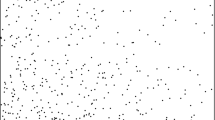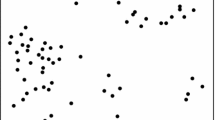Abstract
This manuscript demonstrates an empirical Bayesian estimation of cluster centers (parents) in spatial point pattern. We use the Thomas models on a plane, namely, Neyman–Scott process of a two-dimensional Gaussian-type or its extension to the multi-type species. This manuscript firstly confirms restoration method; namely, the numbers of parents and their locations are estimated from simulated datasets of Thomas process or its multi-type process; and the Metropolis’ simulation of parent locations are well performed from their posterior distributions. Then, we further apply the models to three real datasets of plant ecology, volcano swarms, and inland shallow micro-earthquakes. However, in the latter two cases, a preliminary analysis by the pairwise correlation suggests that the classical second-order moment relationship between the ordinary Thomas process and the Palm intensity cannot be applicable. Therefore, alternative method is implemented by applying a Bayesian selection of the optimal number of parents; which is searched by maximizing the marginal likelihood (integrated posterior) by numerically performing the high-dimensional integration with respective to the location coordinates of the parents. Then, the optimal posterior distribution of the selected model provides the image of likely locations of parents.








Similar content being viewed by others
References
Akaike, H. (1980). Likelihood and Bayes procedure. In Bernard, et al. (Eds.), Bayesian statistics. Spain: University Press. https://doi.org/10.1007/978-1-4612-1694-0_24.
Baddeley, A., Møller, J., & Waagepetersen, R. (2000). Non- and semi-parametric estimation of interaction in inhomogeneous point processes. Statistica Neerlandica, 54, 329–350.
Baddeley, A., Barany, I., Schneider, R., & Weil, W. (2007). Stochastic Geometry Lecture Notes in Mathematics 1892. Berlin: Springer.
Baddeley, A., Ruback, E., & Turner, R. (2016). Spatial point patterns: Methodology and applications with R. London: Chapman & Hall/CRC.
Cressie, N. (1993). Statistics for spatial data (rev ed.). New York: Wiley.
Daley, D. J., & Vere-Jones, D. (1988). An introduction to the theory of point processes. New York: Springer.
Diggle, P. J. (1983). Statistical analysis of spatial point patterns. London: Academic Press.
Geyer, C. J. (1991). Markov chain Monte Carlo maximum likelihood. In E. M. Keramidas (Ed.), Computing science and statistics: 23rd symposium on the interface (pp. 156–163). Fairfax Station: Interface Foundation of North America.
Geyer, C. J., & Thompson, E. A. (1992). Constrained Monte Carlo maximum likelihood for dependent data (with discussion). Journal of the Royal Statistical Society: Series B, 54, 657–699.
Good, I. J. (1965). The estimation of probabilities. Cambridge: MIT Press.
Good, I. J., & Gaskins, R. A. (1971). Nonparametric roughness penalties for probability densities. Biometrika, 58, 255–277.
Green, P. (1995). Reversible jump Markov chain Monte Carlo computation and Bayesian model determination. Biometrika, 82(4), 711–732.
Hastings, W. K. (1970). Monte Carlo sampling methods using Markov chains and their applications. Biometrika, 57, 97–109.
Hawkes, A. G., & Adampoulos, L. (1973). Cluster models for earthquakes—Regional comparisons. Bulletin of the International Statistical Institute, 45(3), 454–461.
Huang, F., & Ogata, Y. (2001). Comparison of two methods for calculating the partition functions of various spatial statistical models. Australian and New Zealand Journal of Statistics, 43, 47–65. https://doi.org/10.1111/1467-842X.00154.
Japan Meteorological Agency (2019). The Seismological Bulletin of Japan. https://www.data.jma.go.jp/svd/eqev/data/bulletin/hypo_e.html
Jerrum, M., & Sinclair, A. (1993). Polynomial-time approximation algorithms for the Ising model. SIAM Journal Computing, 22, 1087–1116.
Lewis, S. M., & Raftery A. E.(1997). Estimating Bayes factors via posterior simulation with the Laplace–Metropolis estimator. Journal of the American Statistical Association, 92(438), 648–655.
McKeague, I. W., & Loizeaux, M. (2002). Perfect sampling for point process cluster modeling. In A. B. Lawson & G. T. Denison (Eds.), Spatial cluster modelling (pp. 87–107). Florida: Chapman & Hall/CRC Press.
Metropolis, N., Rosenbluth, A. W., Rosenbluth, M. N., Teller, A. H., & Teller, E. (1953). Equation of state calculations by fast computing machines. Journal of Chemical Physics., 21, 1087–1092.
Møller, J., Syversveen, A. R., & Waagepetersen, R. P. (1998). Log Gaussian Cox processes. Scandinavian Journal of Statistics, 25, 451–482.
Møller, J., & Waagepetersen, R. P. (2007). Modern statistics for spatial point processes. Scandinavian Journal of Statistics, 34, 643–684.
Neyman, J., & Scott, E. (1958). Statistical approach to problems of cosmology. Journal of the Royal Statistical Society, Series. B, 20, 1–43.
Ogata, Y. (1989). A Monte Carlo method for high dimensional integration. Numerich Mathematik, 55, 137–157. https://doi.org/10.1007/BF01406511.
Ogata, Y. (1990). A Monte Carlo method for an objective Bayesian procedure. Annals of the Institute of the Statistical Mathematics, 42, 403–433. https://www.ism.ac.jp/editsec/aism/pdf/042_3_0403.pdf
Ogata, Y. (1991). Discussion on ‘Bayesian image restoration, with two applications in spatial statistics’ by Besag, York and Mollie: Goodness-of-fit of Bayesian models by the Monte Carlo Simulation. Annals of the Institute of the Statistical Mathematics, 43, 25–32. https://www.ism.ac.jp/editsec/aism/pdf/043_1_0021.pdf#page=5
Ogata, Y. (1995). Markov Chain Monte Carlo integration through simulated annealing and its application to likelihood computation of Bayesian models. Bulletin of the International Statistical Institute, 56(4), 1873–1891.
Ogata, Y. (1996). Evaluating spatial Bayesian models—Two computational methods. Journal of Statistical Planning and Inference, 51, 1–18. https://www.sciencedirect.com/science/article/abs/pii/0378375895000674
Ogata, Y. (2001). Exploratory analysis of earthquake clusters by likelihood-based trigger models. Festschrift Volume for Professor Vere-Jones, Journal of Applied Probability, 38A, 202–212. https://www.jstor.org/stable/3215879?seq=1#page_scan_tab_contents
Ogata, Y., & Katsura, K. (1988). Likelihood analysis of spatial inhomogeneity for marked point patterns, Annals of the Institute of the Statistical Mathematics, 40, 29–39. https://www.ism.ac.jp/editsec/aism/pdf/040_1_0029.pdf
Ogata, Y., Katsura, K., & Tanemura, M. (2003). Modelling heterogeneous space-time occurrences of earthquakes and its residual analysis. Applied Statistics (Journal of the Royal Statistical Society, series C), 52, 499–509. https://doi.org/10.1111/1467-9876.00420.
Ogata, Y., & Tanemura, M. (1981). Estimation of interaction potentials of spatial point patterns through the maximum likelihood procedure, Annals of the Institute of Statistical Mathematics, 33, B, 315–338. https://www.ism.ac.jp/editsec/aism/pdf/033_2_0315.pdf
Ogata, Y., & Tanemura, M. (1984). Likelihood analysis of spatial point patterns. Journal of the Royal Statistical Society, B46, 496–518. https://doi.org/10.1111/j.2517-6161.1984.tb01322.x.
Ogata, Y., & Tanemura, M. (1985). Estimation of interaction potentials of marked spatial point patterns through the maximum likelihood method, Biometrics, 41, 421–433. https://www.jstor.org/stable/2530867?seq=1#page_scan_tab_contents
Ogata, Y., & Tanemura, M. (1986). Likelihood estimation of interaction potentials and external fields of inhomogeneous spatial point patterns. Proceedings of the Pacific Statistical Congress—1985 (pp. 150–154), North-Holland.
Ogata, Y., & Tanemura, M. (1989). Likelihood estimation of soft-core interaction potentials for Gibbsian point patterns. Annals of the Institute of the Statistical Mathematics, 41, 583–600. https://www.ism.ac.jp/editsec/aism/pdf/041_3_0583.pdf
Prokešová, M., & Vedel Jensen, E.B.(2013). Asymptotic Palm likelihood theory for stationary point processes, Annals of the Institute of the Statistical Mathematics, 65, 387–412. https://doi.org/10.1007/s10463-012-0376-7. https://www.ism.ac.jp/editsec/aism/pdf/10463_2012_Article_376.pdf
Ripley, B. (1977). Modelling spatial patterns (with discussion). Journal of the Royal Statistical Society: Series B, 39, 172–212.
Stoyan, D., & Stoyan, H. (1996). Estimating pair correlation functions of planar cluster processes. Biometrical Journal, 38, 259–271.
Stoyan, D., Kendall, W. S., & Mecke, J. (1995). Stochastic geometry and its applications (2nd ed.). Chichester: Wiley.
Takahashi, H., & Mori, M. (1973). Quadrature formulas obtained by variable transformation. Numerich Mathematik, 21, 206–219.
Tanaka, U. & Ogata, Y. (2014). Identification and estimation of superposed Neyman–Scott spatial cluster processes, Annals of the Institute of the Statistical Mathematics, 66. https://doi.org/10.1007/s10463-013-0431-zhttps://www.ism.ac.jp/editsec/aism/pdf/10463_2013_Article_431.pdf
Tanaka, U., Ogata, Y., & Katsura, K. (2008). Parameter estimation and model selection for Neyman–Scott point processes. Computer Science Monographs, No. 34, The Institute of Statistical Mathematics, Tokyo. https://www.ism.ac.jp/editsec/csm/pdf/csm_034.pdf
Tanaka, U., Ogata, Y., & Stoyan, D. (2007). Parameter estimation and model selection for Neyman–Scott point processes. Biometrical Journal. https://doi.org/10.1002/bimj.200610339.
Terakawa, T., & Matsu’ura, M. (2010). The 3-D tectonic stress fields in and around Japan inverted from centroid moment tensor data of seismic events. Tectonics, 29, 1–14. https://doi.org/10.1029/2009TC002626.
Thomas, M. (1949). A generalization of Poisson’s binomial limit for use in ecology. Biometrika, 36, 18–25.
Van Lieshout, M. N. M., & Baddeley, A. J. (1996). A nonparametric measure of spatial interaction in point patterns. Statistica Neerlandica, 50, 344–361.
Vere-Jones, D. (1970). Stochastic models for earthquake occurrence (with discussion). Journal of the Royal Statistical Society: Series B, 32, 1–62.
Vere-Jones, D., & Davies, R. B. (1966). A statistical survey of earthquakes in the main seismic region of New Zealand, Part 2, Time series analyses. New Zealand Journal of Geology and Geophys., 9, 251–284.
Waagepetersen, R. (2007). An estimating function approach to inference for inhomogeneous Neyman–Scott processes. Biometrics, 63, 252–258.
Wood, W. W. (1968). Monte Carlo studies of simple liquid models. In H. N. V. Temperley, J. S. Rowlinson, & G. S. Rushbrooke (Eds.), Physics of simple liquids (pp. 115–230). Amsterdam: North-Holland.
Acknowledgements
The author would like to thank Professor Jim Mori of Kyoto University for the Rabaul Volcano micro-earthquake data, anonymous two reviewers for careful reading of the papers and useful comments and also the Japan Meteorological Agency for the inland micro-earthquake data, the National Research Institute for Earth Science and Disaster Resilience (NIED), and the relevant universities for providing hypocenter data. This study is partially supported by JSPS KAKENHI Grant Number 17H00727.
Author information
Authors and Affiliations
Corresponding author
Additional information
Publisher's Note
Springer Nature remains neutral with regard to jurisdictional claims in published maps and institutional affiliations.
Rights and permissions
About this article
Cite this article
Ogata, Y. Cluster analysis of spatial point patterns: posterior distribution of parents inferred from offspring. Jpn J Stat Data Sci 3, 367–390 (2020). https://doi.org/10.1007/s42081-019-00065-9
Received:
Accepted:
Published:
Issue Date:
DOI: https://doi.org/10.1007/s42081-019-00065-9




